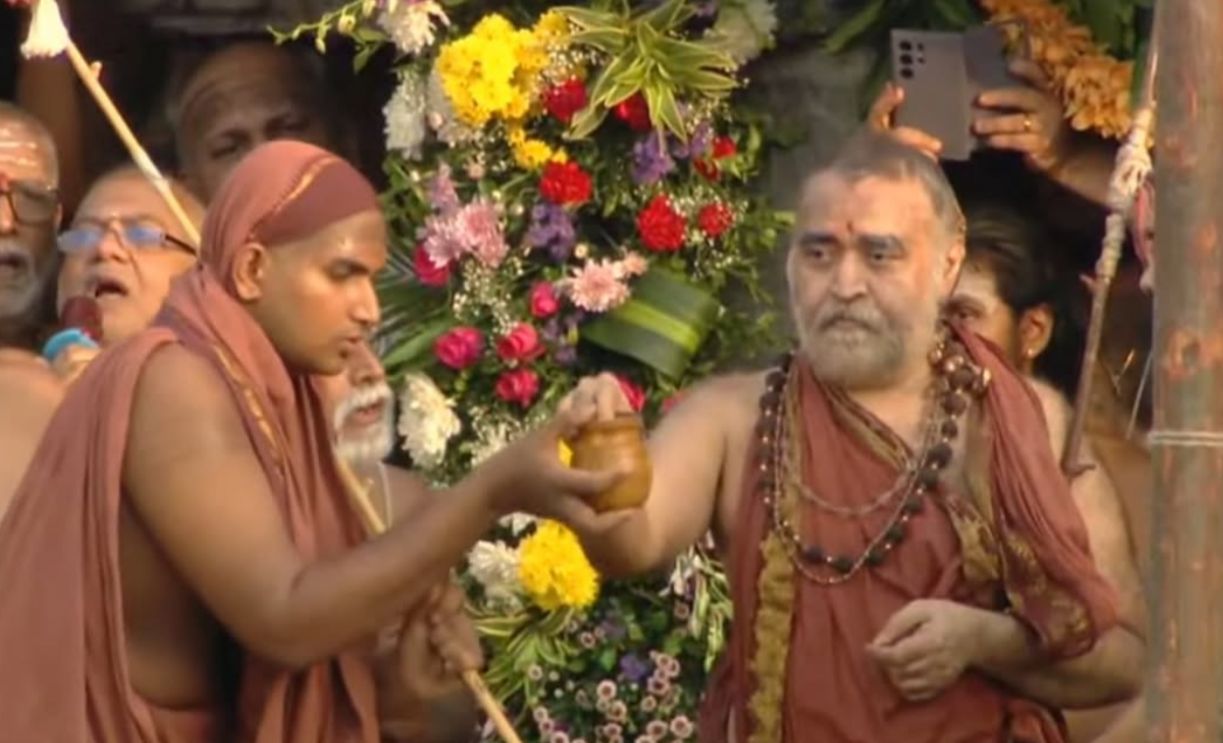The initiation ceremony was held two days ahead of the 2534th birth anniversary of Adi Shankaracharya, who set up the mutt in 482 BC.
Published Apr 30, 2025 | 12:54 PM ⚊ Updated Apr 30, 2025 | 12:54 PM

The 70th Pontiff, Sri Vijayendra Saraswathi Swamigal, installed Ganesha Sharma, hailing from Annapuram in Andhra Pradesh, as the new Peetadhipadhi at a sacred ceremony in Kachipuram's Kamakshi Amman Temple.
Synopsis: Sri Subramanya Ganesha Sharma, Rig Veda scholar from Annavaram in Andhra Pradesh, was anointed as the 71st Pontiff of the Kanchi Sankara Mutt. He has been bestowed with the spiritual name, Sri Sathya Chandrasekharendra Saraswathi Swamigal.
Duddu Satya Venkata Surya Subramanya Ganesha Sharma Dravid was anointed as the 71st Pontiff (Peetathipathi) of the Kanchi Sankara Mutt on Wednesday, 30 April.
The 70th Pontiff, Sri Vijayendra Saraswathi Swamigal, installed Ganesha Sharma, hailing from Annapuram in Andhra Pradesh, as the new Peetathipadhi at a sacred ceremony in Kachipuram’s Kamakshi Amman Temple.
The initiation ceremony was held on Akhshaya Tritiya, two days ahead of the 2534th birth anniversary of Adi Shankaracharya, who set up the mutt in 482 BCE.
Following the ceremony, both pontiffs had darshan (divine viewing) of Goddess Kamakshi. The newly initiated junior pontiff was bestowed with the spiritual name Sri Sathya Chandrasekharendra Saraswathi Swamigal by Sri Vijayendra Saraswathi Swamigal.
The two pontiffs were then taken in a ceremonial procession from the Kamakshi Amman Temple to the Sankara Mutt, accompanied by auspicious traditional music. At the mutt, the new junior pontiff received spiritual instruction and officially assumed the responsibilities as the 71st head of the Peetam.
A Rig Veda scholar
Ganesha Sharma hails from Andhra Pradesh and is the son of Srinivasa Surya Subramanya Dhanvanthri and Alamelu Mangadevi.
It is said that when he first met the current pontiff, he personally encouraged him to take up Vedic studies. Following his advice, Ganesha Sharma underwent traditional gurukul training for 12 years under the guidance of Sandukudlu Hosamane Ratnakara Bhat Sharma from Karnataka. He stayed at the teacher’s residence and served him as a disciple while undergoing rigorous Vedic education.
He went on to master the Rig Veda Samhita, Aitareya Brahmana, Aranyaka, Upanishads, and Pada and Krama recitation methods. He also studied advanced Vedic texts such as Pratishakhya, Vyali Shiksha, and the Jatapatha.
Recognising his dedication and expertise, the current pontiff appointed Ganesha Sharma as his spiritual successor.
Ganesha Sharma is a Rig Veda scholar and has received the “Shalakshana Ganapati” award — a recognition for complete mastery in Rig Vedic studies. He has also studied the Yajur and Sama Vedas, along with the six auxiliary disciplines known as Shadangas, and 10 Upanishads (Dashopanishads).
He has served at the Sri Gnana Saraswati Temple in Basara, located in the Nirmal district of Telangana.
History of Kanchi Sankara Mutt
The Kanchi Sankara Mutt claims a long spiritual lineage. According to its official website, the mutt traces its origins to Adi Shankaracharya, who is said to have been born in 509 BCE and to have attained moksha (spiritual liberation) in Kanchipuram after spending his final days there. The mutt claims it was established in 482 BCE.
After Adi Shankaracharya, successive spiritual leaders guided the Mutt. During the tenure of Sri Chandrasekharendra (1746–1783 CE), the 62nd pontiff, the mutt was temporarily relocated to southern Tamil Nadu due to political unrest in Kanchipuram.
It functioned for some time in Ramanathapuram, Thiruvananthapuram, Pudukkottai, and Udayarpalayam before being shifted to Thanjavur in 1760 at the invitation of King Pratap Simha.
In 1907, Sri Chandrasekharendra Saraswathi was appointed as the 68th pontiff at the age of 13. In 1954, he nominated Jayendra Saraswathi as his successor. Later, in 1983, Jayendra Saraswathi designated Vijayendra Saraswathi as the next in line.
Notably, Vijayendra Saraswathi, who hails from Thandalam village near Ponneri in Tamil Nadu, was given the title of 70th junior pontiff of the mutt when he was just 14 years old.
However, there are opposing views regarding the origins of the Kanchi Mutt. Critics argue that the mutt was not established by Adi Shankara. Some claim that it was originally a branch of the Sringeri Mutt, set up in Kumbakonam in 1821, and it later declared independence from Sringeri.
They asserted that it relocated to Kanchipuram in 1839, proclaiming itself as the head Peetam. Currently, the Kanchi Sankara Mutt has nearly 85 branches across India, including in cities like Bengaluru, Bhopal, Ahmedabad, and Ayodhya.
A major controversy erupted in the Mutt in 2004 when Shankararaman, the manager of the Varadaraja Perumal Temple in Kanchipuram, was brutally murdered inside the temple premises on 3 September that year.
Shankararaman had been a vocal critic of both Jayendra Saraswathi and Vijayendra Saraswathi. He had even written to Jayendra Saraswathi, threatening legal action to remove him from the pontifical position.
Following his murder, a case was filed against 25 individuals, including the then-pontiff, Jayendra Saraswathi, and the current pontiff, Vijayendra Saraswathi. Both were arrested but later released on bail.
In the subsequent trial held at the Puducherry district sessions court, all the accused were acquitted. However, questions remained. There were allegations that the witnesses had been intimidated and that the trial had been manipulated in favour of the accused. To this day, the murder of Shankararaman remains an unresolved mystery.
(Edited by Majnu Babu).
